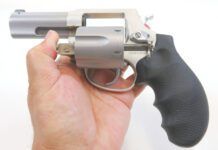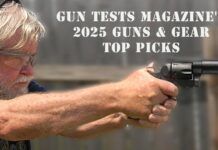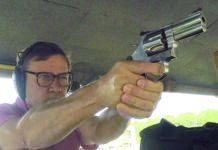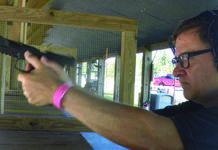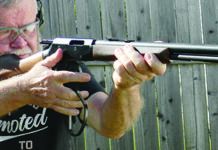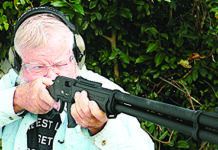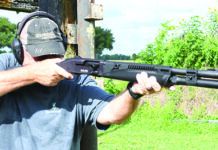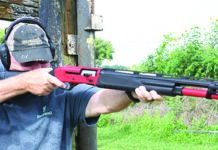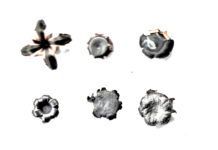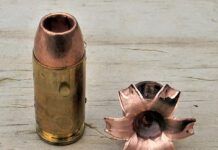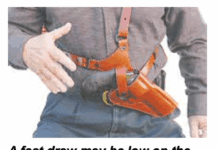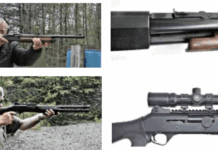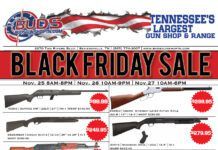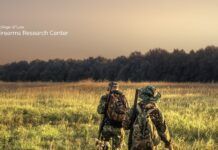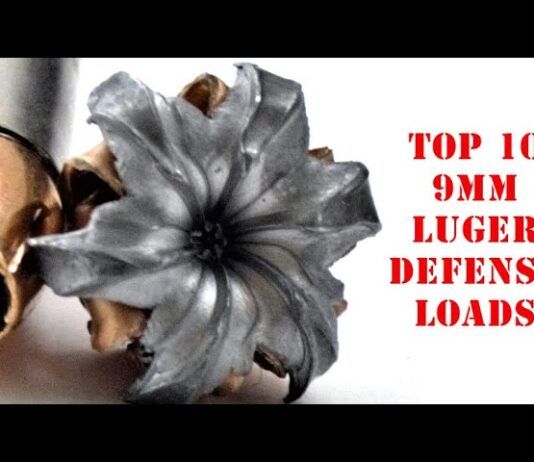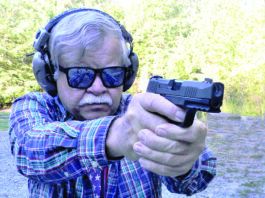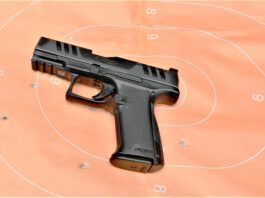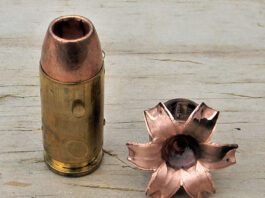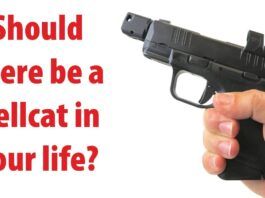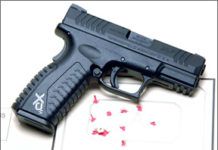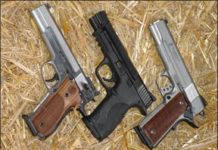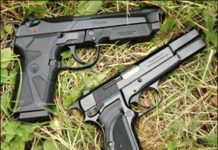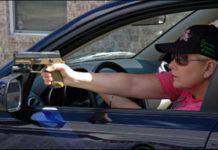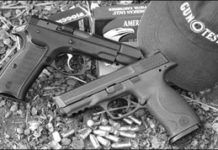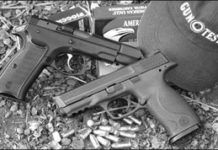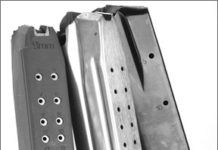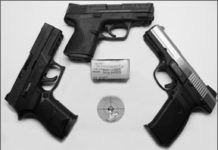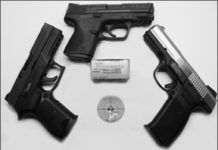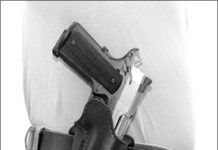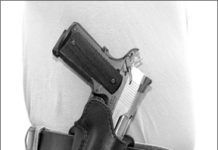9mm Compact Pistols: Ruger, Springfield, CZ USA, and Glock
Recently, we received a letter urging us to test more deep-concealment guns, claiming that they are the most popular gun of the day. Checking with one of the larger distributors confirmed that it is the subcompact and micro guns that are currently driving the market. In this test we're not going to evaluate pocket guns, but we are going to shoot four compact pistols that in are just one step larger than the smallest model available from each manufacturer.
The first test gun we chose was the $697 XDM 3.8 from Springfield Armory. Since the first XD pistol to hit our shores from Croatia was the Four-inch Service Model, we were tempted to refer to the XDM 3.8 as belonging to a "sub-service" category. The $525 Ruger SR9C is another new model that attempts to cross over the design of a larger pistol (the Ruger SR9) into the role of concealed carry. The $646 Glock G19 is the smaller brother of the G17, found on the hip of law enforcement worldwide. The Glock 19 gets little press, but remains popular. Another pistol that continues to perform is the CZ 75B. In this test we shoot one of its little brothers, the $651 CZ USA 75D PCR Compact.
Throughout our tests, each gun ran reliably without a single malfunction. The Glock, Ruger, and Springfield Armory pistols operated with a single continuous trigger system. The Glock 19 required a longer trigger press because movement of the trigger is what loads the spring to propel the striker, or firing pin. Release of the striker was part two of this double-action system. The XDM 3.8 utilized the trigger to release the striker after rearward movement of the slide had loaded the striker spring nearly to full strength. Pressing the trigger on the XD series pistols tops off the compression of the striker spring and releases the trigger. The Ruger SR9C works with a similar action, but the trigger applied more final compression to the striker spring than the XD/XDM. The CZ is a hammer-driven pistol with two modes of fire. Once the slide has been moved rearward, the hammer stays back [IMGCAP(2)]and trigger is used for the single action of releasing the hammer. But after using the decocker to lower the hammer to a locked position about 0.36 inches from the firing pin, pressing the trigger will perform two actions. First to move the hammer rearward, and, second, to release it toward the firing pin. To collect accuracy data, our test team fired the CZ 75D PCR Compact from the bench in single action only.
We began with three choices of test ammunition, consisting of Remington UMC 115-grain JHP rounds, Federal American Eagle 124-grain FMJ rounds and 115-grain FMJ rounds of new manufacture (red box) Black Hills ammunition. When we realized our supply of the American Eagle rounds was going to be limited, we decided to shoot our action tests with a fourth, less expensive, round. These were the Black Hills remanufactured 124-grain FMJ rounds sold in the blue boxes. Curious about the accuracy of these economical rounds, we decided to add them to our bench session. Test distance from support was 15 yards.
After accuracy data had been collected from our bench session, we set up a timed close-quarters exercise. For this test we posted a paper replica of an IPSC Metric target 7 yards downrange. The drill was to engage the target with two shots to the 5.9-by-11-inch rectangular A-zone at center mass, and then a third shot to the upper A-zone. The upper A-zone measured about 4-by-2 inches and represented the cranial pocket of this roughly humanoid silhouette. After ten runs we looked for 20 hits to the "chest" and ten to the head. Start position was holding the pistol in both hands at roughly the position one would clap their hands. We kept track of elapsed time by using a shot-activated timer and took note of our accuracy. Our operator began by dry-firing the exercise at the command of the audible start signal. Once the operator was able to completely visualize the run, at the sound of the timer the shooter was ready for live fire. But keep in mind that each gun was afforded one try and one try only at our action test. We almost broke this promise when it came time to test the CZ pistol. It was the last gun to be field tested and we suddenly realized that we had not yet fired the pistol beginning with a double-action first shot. We even went so far as to write in a warmup round on our score card. Then we decided to take the challenge and report how we shot the CZ from first-shot double action under pressure without additional practice.
Smith Lovers Quandary: Is One Of These 9mms Right for You?
In this test we have a diverse trio of pistols that offer a wide look at some of what's available in the world of Smith & Wesson's full-size 9mm handguns. We acquired a striker-fired M&P 9 Pro Series with fiber optic front sight (No. 178010, $830). Next up was a 9mm 1911-type pistol in the SW1911 Pro Series (No. 178017, $1683). Last, we assessed the Performance Center-built Model 952 (No. 170244, $2402), which is essentially a remake of the old 38-Special-only Model 52, but for 9mm ammunition.
All three of these guns felt considerably different in the hand, as though they were made on totally different planets. They were all set up to some extent for self defense. Even the 952 had a relieved magazine well for fast reloads. The M&P9 held 17+1 rounds, the SW1911 held 10+1, and the 952 held 9+1 rounds. The weights of these guns were also quite different, the heaviest being the 1911, which also had thick grip panels that we found to be a touch on the over-filling side.
We tested the trio with Fiocchi 115-grain JHP, Black Hills 147 FMJ, and with Winchester BEB 115-grain truncated-cone ammo. We evaluated the three guns for self-defensive use, and also for potential target shooting, particularly the 952. Here's what we found.
Full-Size 9mm 1911-Style Pistols: Kimber, Springfield, STI
It could be said that the Browning 1911 pistol has evolved more than any other design. The operating principal remains the same, but alternate configurations have been applied to nearly every facet of its execution. In fact, it is now commonplace to buy over the counter what not long ago would have been considered a full-blown custom pistol. We all know about beveled magazine wells, frame checkering, undercutting the trigger guard for a higher grip, high-arch memory groove grip safeties, extended magazine releases, aluminum triggers adjustable for overtravel, light rails on the dust cover, extended and/or ambidextrous safeties, checkered slide stops, skeletonized hammers, titanium firing pins, front and rear serrations on the slide, weight reducing slide cuts, lowered and flared ejection ports, full length guide rods, bull barrels, multi-spring recoil systems, external extractors, spring-loaded internal extractors, ramped barrels, adjustable sights for target, adjustable low-mount sights for carry, light-gathering-filament sights, or self-illuminating modules for front and rear sights.
In this test we will evaluate three full-size 1911-style pistols that include several of the above-mentioned features. A few years ago we would have called them factory customs, but that term is obsolete. The most distinguishing characteristic of our trio was that all were chambered for 9X19 shells, aka 9mm Parabellum or simply 9mm. They are the $1299 STI Duty One, Springfield Armory's $1277 Loaded Full Size Stainless Steel 9X19 No. PX9130LP, and the $1277 Kimber Custom Aegis II. All three guns shipped with and fed from identical 9-round MetalForm-brand single-stack magazines. Otherwise, there were significant differences between the pistols. Each gun represented a different viewpoint of what a 9mm 1911 should be. As a result, each gun had a slightly different personality, which we took into account in our grading.
The holiday season was upon us and the radio was playing old favorites like "Baby It's Cold Outside." So we accepted an offer from Houston's Top Gun Training Center to conduct our test indoors. The range was under renovation, so while the ActionTarget.com folks were working their magic on one shooting bay, we set up targets at the other end of the building. Test distance was 15 yards and Black Hills ammunition was used exclusively in our tests. For break in we opened a case of 124-grain FMJ ammunition packed in blue boxes (remanufactured). Both our 115-grain FMJ and 124-grain JHP rounds were new manufacture (packaged in red boxes). We brought in a portable shooting bench and went to work firing five-shot groups. Here is what we learned.
Two Full-Size 9mms: Browning Hi-Power Loses to Bulky 90-Two
Polymer 9mm Pistols: Green, Dark Earth, and Black Beauties
During a visit to Top Gun Range in Houston (topgunrange.com), one of our favorite retail gun shops, two colorful 9mm polymer pistols caught our eye. One was the Springfield Armory XD Service Model No. XD9201HCSP06, with an olive-drab-green frame and black slide, $543. The other pistol was the SIG Sauer P250 Compact No. 2509205, with a dark-earth-colored grip and Melonite-black slide. Both of these pistols were double-action-only, but from the operators' point of view, their unique triggers gave each gun a different personality. A comparison test was in order but we wanted to add a third pistol. That's when we found a new model from CZ USA that was also a polymer 9mm semiautomatic. The CZ USA P-07 Duty arrived as a DA/SA, traditional double-action pistol. But the P0-7 was also shipped with an optional set of ambidextrous thumb levers. When swapped out with the decocker levers, the P-07 could be fired single-action-only with a thumb-operated safety. We decided to focus our test on the single-action capability of the P-07 because it was the only mode in which operation of the trigger remained constant. This played into our desire to test three polymer nines, each with a different, but simplified, way to light the fuse.
For accuracy tests we fired from sandbag rests at targets placed a measured 15 yards downrange. We also staged a rapid-action test from a distance of 7 yards. For our 15-yard session we fired Black Hills 115-grain full-metal jacketed ammunition, (Black-Hills.com), and two choices from the catalog of Atlanta Arms and Ammo, (AtlantaArmsandAmmo.com). They were the 125-grain HAP rounds and the AAA Sub Sonic 147-grain JHP Match ammunition. For our 7-yard session we fired 124-grain FMJ rounds from Black Hills. Both the 147-grain and 124-grain rounds were sold in blue boxes, signifying that they were remanufactured ammunition. During the benchrest session, our pistols were fired utilizing a controlled press with the sights on target and the gun fully supported. Our rapid-action session was performed standing in front of a Hoffners ABC16 target, (from hoffners.com, 877-463-3637). The point of aim was the A-zone/chest area and the B-zone/head. The shooter began with the gun in both hands chest high. The muzzle was canted slightly upward so that the front sight was at the bottom of the shooter's peripheral vision. The trigger finger began resting along the frame outside the trigger guard. Upon an audible start signal from a shot-recording timer, the shooter pressed the gun toward the A-zone, fired two shots then moved the sights upward to deliver one more hit to the B-zone. We took note of shot placement and recorded the elapsed time for each of 10 recorded runs. Since we were testing at Top Gun Handgun Training Center, a public indoor range which tends to be louder than an outdoor setting, we were wearing ear plugs as well as ear muffs. Taking note of the elapsed time between the buzzer and the first shot, we kept in mind the slight delay to our hearing as well as the physical manipulation necessary to deliver a first shot. Subtracting the first shot ET from the total time told us more about recoil management, trigger control and sight alignment. Happily, none or our guns showed any hint of malfunction when firing, so we were able to concentrate on the essential operation of each weapon. Here is what we found.
Two Big 9mms: High-Capacity, Full-Size Self-Defense Picks
Two Big 9mms: High-Capacity, Full-Size Self-Defense Picks
High-Capacity Full-Size 9mms: CZ-USAs Phantom Shows Up
If we were to list the reasons for the boom in popularity of the semiautomatic handgun, high capacity would be at the top. The highest-capacity pistols are typically chambered for 9mm because the cartridges are slender and you could pile a lot of them on top of each other. In this test we will shoot three 9mm pistols that subscribe heartily to the plan of carrying as many rounds as the frame will permit. With the rush on guns and ammo we actually had some difficulty putting this test together, but we found everything we needed at Jim Pruett's Anti-Terrorist Headquarters.
Each pistol represents the highest capacity available from the respective manufacturer. The $749 Springfield Armory XDM9211HCSP is the 9mm version of the largest-framed Croatian police pistol that was introduced chambered for 40 S&W just a few months ago. The $695 CZ SP-01 Phantom No. 91158 is a fresh variation of the venerable CZ75 pistol. It features a polymer frame with interchangeable panels at the rear of the grip. Our third pistol is a benchmark among high-capacity 9mm pistols. The $680 Glock 34 takes the large-receiver Model 17 and tops it with a longer barrel and adjustable sights. The design of each of these guns has been influenced by the demands of the Practical Shooting crowd and should make ideal weapons for home defense, duty carry, or open carry for the civilian.
With the possible exception of the CZ pistol, the operation of each gun was a known quantity. So our evaluation will spend most of its time and ink on performance and describing a test drive. With maximum available sight radius available on each gun (another benefit of the full-size pistol), we chose to record accuracy data from a distance of 25 yards. For support we used a $49 Caldwell Rock Jr. shooting rest beneath the dust cover of each pistol and a $19 pre-filled Caldwell Elbow Bag to support our hands, both from battenfeldtechnologies.com. The Rock Jr. proved stable without being unnecessarily heavy. The pre-filled bag stayed tight and didn't compress so much that we had to reset the guns after every shot. With these tools we were able to do our best despite the gusting winds racing across the Texas plains.
To learn more about the rapid-fire capability of each weapon, we created an action test. We placed three targets downrange in a triangular pattern. The central target was directly in front of the shooter 50 feet downrange. The flanking targets were each 30 feet downrange and 15 feet from the center line. The targets were police training targets with a 3-inch circle of Caldwell Orange Peel target pasted at dead center. The drill was to raise the pistol from a tactical low ready (a drop of the sights from the target low enough to give view of the subject's hands), and engage the targets from left to right with two shots each. Beginning with a full magazine, the drill was fired in six-shot strings until the magazine was empty. The test was concluded when we had exhausted two full magazines worth of ammunition. Our pace was held to about the same for each pistol. We wanted to see consistent hits and collect shooter feedback. This means what the shooter saw and what adjustments had to be made to land the required hits.
Test ammunition consisted of the latest generation of Black Hills 124-grain FMJ remanufactured ammunition and new manufacture 115-grain FMJ rounds. The 124s were used in our multiple-target drill. We also fired 124-grain Speer Gold Dot Hollowpoints, which gave us a scare during our chronograph of the Glock pistol. Without warning one of the rounds appeared to overpressure, causing the G34 to jump violently. Recorded velocity of that round was 1311 fps. This was more than 100 fps faster compared to previous shots through the chronograph. We did not recall a similar experience when firing from the bench, so we do not think this interfered with the accuracy of our data. Range conditions offered amenable temperatures but gusting winds and shifting light. Let's see what we learned about these three high-capacity sidearms.


